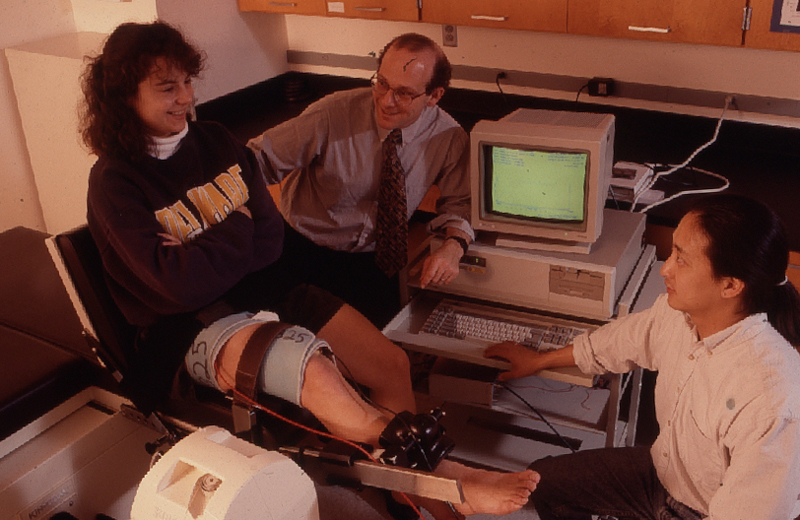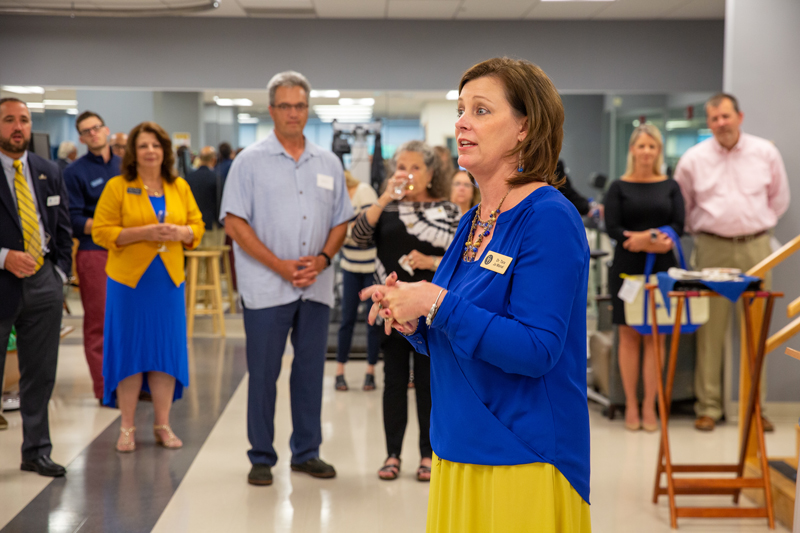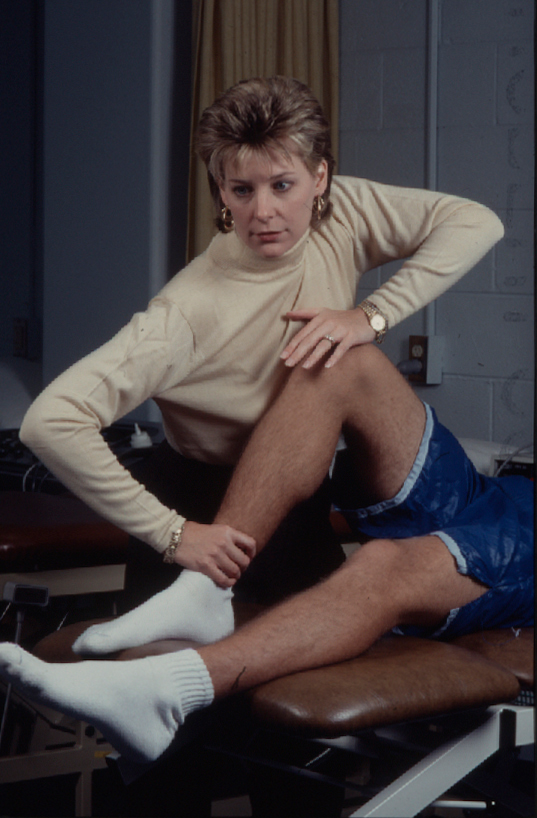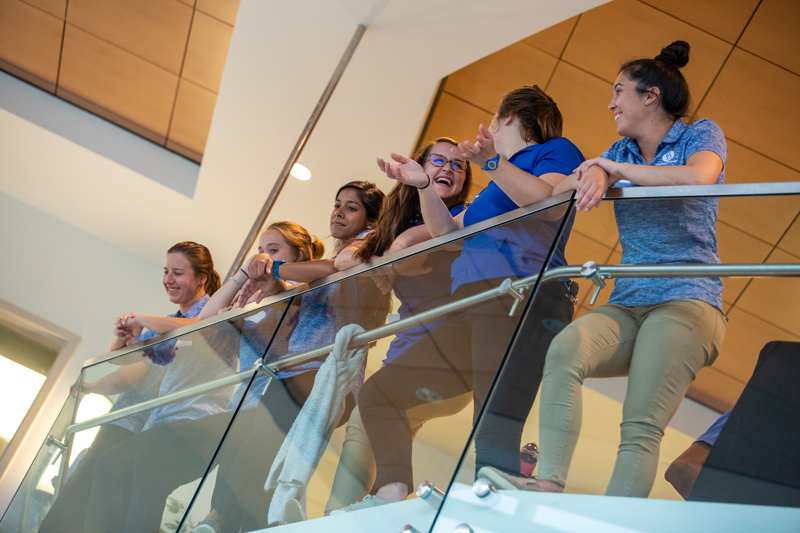


UD Physical Therapy Clinic celebrates 25 years
Photos by Ashley Barnas and Physical Therapy Department October 25, 2019
Top-ranked department marks a milestone in teaching and patient care
The University of Delaware Physical Therapy Clinic has grown exponentially since its humble beginnings in the basement of McKinly Lab more than 25 years ago.
In those early years, the PT clinic, lab and classroom all shared the same crowded space. Patients maneuvered stairs and long walks for their appointments in the makeshift clinic that opened each afternoon at about 4 p.m., once the student desks and equipment were pushed to one side.
But a solid reputation for providing patient care and a positive relationship with local healthcare professionals helped the clinic grow — enough to eventually warrant additional classroom space in McKinly so the clinic could continue to operate.
Today, the 9,800-square-foot clinic housed in the Health Sciences Complex on the Science Technology and Research (STAR) Campus handles more than 25,000 patient visits each year, including 15,570 treatments provided by 122 mentored PT doctoral students. UD’s physical therapy program is currently ranked number one in the nation among graduate PT programs by U.S. News and World Report.

Former patients, students and supporters of the clinic gathered recently at the STAR Campus to celebrate the clinic, which opened as a fee-for-service operation in 1994. Guests celebrated the clinic’s history and its ongoing impact on both the community and the students in the physical therapy department.
“The reason why this space is so important to us is not just the clinical care it brings and the opportunity to train our students, but it also gives us an opportunity to really translate our research into something that has an impact right now,” College of Health Sciences Dean Kathleen S. Matt said.
“The idea that discovery and research, in the same time span, should then translate to an impact in the community and in patients and individuals — I think that is what physical therapy has shown really strongly and really led the way.”
Developing the model
Physical therapy was not yet its own department when Lynn Snyder-Mackler was hired as one of four junior faculty members in the late 1980s. Snyder-Mackler was supposed to teach exercise physiology, but she asked then-department chair Paul Mettler if she could take charge of the PT clinic.

“The fact a clinic actually existed was something that attracted me to Delaware,” said Snyder-Mackler, now the Alumni Distinguished Professor in the Department of Physical Therapy. “I needed to be able to do studies that involved how do we best provide rehab to people and preserve their function. For me, the fact we had a clinic here meant I had a lab.”
The clinic was a pro bono operation serving students and UD faculty when Snyder-Mackler took it over in 1989. The PT program operated out of two rooms in McKinly Lab, which meant the clinic based its open hours around the time needed for classroom and lab instruction.
“At 4 p.m., the chairs were shoved into a closet and we hoped it would stay shut and then we treated students and faculty and staff for free,” she said.
Over the next few years, the clinic began the transition to a fee-for-service model, which meant overcoming several business hurdles, including deciding how much to charge, creating a billing practice and signing contracts with private insurance companies and Medicare, the federal government’s health insurance plan for seniors.
“Nobody knew how to do it. The fact we actually did it is miraculous,” Snyder-Mackler said. “That it succeeded is less of a surprise we because we had quality people and we did good work.”
Developing a reputation for excellence
From the beginning, the clinic was designed to be a teaching and learning opportunity for students. As part of the program, students were required to spend a rotation in the clinic. As the clinic moved to a paying model, student involvement was formalized with two students working a rotation under one supervisor. This education model turned out to be a national one for other physical therapy programs.
“Students go on lots of internships in the program, but this is an environment where they are literally learning something in class and using it,” said Mettler, now professor emeritus in the physical therapy department. “The immediacy of the experience is phenomenal.”
The switch to a fee-for-service clinic was completed by 1994, and by 1998, Stuart Binder-Macleod was named the PT department chair. UD alum John Knarr was hired as the first clinical director, along with some part-time help. Eventually, Knarr was able to carve out space for an office — in what was previously a closet.

The clinic decor may have been sparse, but the department’s commitment to helping patients and teaching the next generation of physical therapists quickly garnered the clinic a reputation for excellence.
“Having the faculty available for a consult was a tremendous advantage as they had national recognition and refereed journal publications in each of their specialties,” said Knarr, a partner in Elite Physical Therapy and a 2019 recipient of the UD Alumni Association Outstanding Alumni award. “The students were being exposed to current research as it was applied to the patient. Who could ask for a better stimulating environment and opportunity to grow professionally? We were setting the standards for how patients should be treated.”
Expanded services
In addition to providing sports and orthopedic care, the PT clinic expanded its patient offerings to include neurological and care for older adult populations. The growth of the clinic paralleled the rise of the department, which added a doctor of physical therapy program and more clinically minded faculty with an interest in research. Residencies in sports, orthopedics, geriatrics, neurology and acute care created even more opportunities for UD physical therapy students to develop a specialty in the field.
As the clinic grew, one aspect of the program remained the same — the connection to patients and the commitment to provide them with exceptional care. From the beginning, patient interaction was an integral part of the educational process. Students learned from patients, who in turn benefit from access to board-certified physical therapists trained in the latest research.
“We still are very unique in that our mission is the mission of the university — research, teaching and service,” said Snyder-Mackler. “We never stray very far from that. We are first and foremost a teaching clinic. Our patients have to understand they are part of the process. They are co-teachers with our students.”
Renovations and expansions in McKinly Lab allowed the clinic to grow its footprint, but space remained a challenge. That changed in 2014 with the opening of the new Delaware Physical Therapy Clinic on the STAR Campus. With a state-of-the-art facility to match the high caliber of care already provided in the clinic, it was no surprise the appointment books quickly filled up.
“Moving to STAR, there was explosive growth,” Binder-Macleod said.
The sterling reputation of the PT department and clinic was further cemented by the PT department being named the top graduate program in the nation in the 2017 edition of the U.S. News and World Report’s Best Graduate Schools. For faculty who remember those early days in the basement of McKinly, it was a reminder of how far the program has come.
“It’s hard to think back to 1989. I couldn’t have imagined it at all the way this has evolved,” Binder-Macleod said. “It’s beyond my wildest dreams.”
Contact Us
Have a UDaily story idea?
Contact us at ocm@udel.edu
Members of the press
Contact us at 302-831-NEWS or visit the Media Relations website

